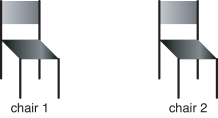Artificial
Intelligence 2E
foundations of computational agents
The third edition of Artificial Intelligence: foundations of computational agents, Cambridge University Press, 2023 is now available (including full text).
13.7 Equality
Sometimes it is useful to use more than one term to name a single individual. For example, the terms , , , and may denote the same number. Sometimes, you want to have each name refer to a different individual. For example, you may want unique names for different courses in a university. Sometimes you do not know whether or not two names denote the same individual – for example, whether the 8 a.m. delivery person is the same as the 1 p.m. delivery person.
This section considers the role of equality, which allows us to represent whether or not two terms denote the same individual in the world. Note that, in the definite clause language presented earlier in the chapter, all of the answers were valid whether or not terms denoted the same individuals.
Equality is a special predicate symbol with a standard domain-independent intended interpretation.
Term equals term , written , is true in interpretation if and denote the same individual in .
Equality does not mean similarity. If and are constants and , it is not the case that there are two things that are similar or even identical. Rather, it means there is one thing with two names.

Example 13.43.
Consider the world of two chairs given in Figure 13.14. In this world it is not true that , even though the two chairs may be identical in all respects; without representing the exact position of the chairs, they cannot be distinguished. It may be the case that . It is not the case that the chair on the right is similar to chair2. It is chair2.


